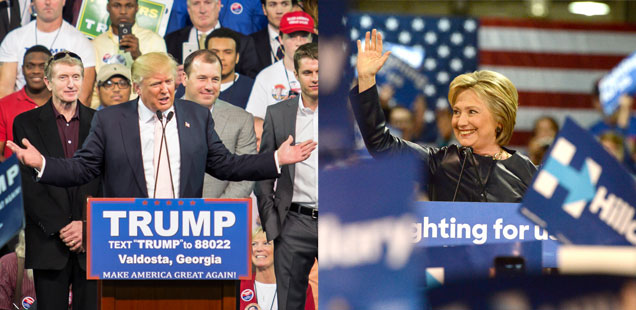The Shorenstein Center on Media, Politics and Public Policy produced a multi-part research series analyzing news media coverage of candidates and issues during the 2016 presidential election. The reports were authored by Thomas E. Patterson, Bradlee Professor of Government and the Press, with data provided by Media Tenor, a firm that specializes in content analysis of news coverage. The research was partially funded by the John S. and James L. Knight Foundation.
![]()
Part 1: January–December 2015 | Pre-Primary News Coverage of the 2016 Presidential Race: Trump’s Rise, Sanders’ Emergence, Clinton’s Struggle
This report analyzes news coverage of the 2016 presidential candidates in the year leading up to the primaries. The analysis is based on news statements by CBS, Fox, the Los Angeles Times, NBC, The New York Times, USA Today, The Wall Street Journal, and The Washington Post.
Key findings:
- During 2015, major news outlets covered Donald Trump in an unusual way given his low initial polling numbers—a high volume of media coverage preceded Trump’s rise in polls.
- Trump’s coverage was positive in tone—he received far more “good press” than “bad press,” largely in the context of the “horserace,” centering on his growing crowds and momentum. The coverage helped propel Trump to the top of Republican polls.
- The Democratic race in 2015 received less than half the coverage of the Republican race, partly as a result of journalists’ focus on Trump.
- Bernie Sanders’ campaign was largely ignored in the early months but, as he began to get coverage, it was overwhelmingly positive in tone. Sanders’ coverage in 2015 was the most favorable of any of the top candidates, Republican or Democratic.
- Hillary Clinton had by far the most negative coverage of any candidate. In 11 of the 12 months, her “bad news” outpaced her “good news,” usually by a wide margin, contributing to her increasingly unfavorable poll ratings in 2015.
Part 2: January–June 2016 | News Coverage of the 2016 Presidential Primaries: Horse Race Reporting Has Consequences
This report analyzes news coverage of the 2016 presidential primary races, based on news statements by CBS, Fox, the Los Angeles Times, NBC, The New York Times, USA Today, The Wall Street Journal, and The Washington Post. The report analyzes coverage of Donald Trump, Ted Cruz, Marco Rubio, John Kasich, Hillary Clinton, and Bernie Sanders.
Key findings:
- Trump received much more coverage than the other presidential candidates. His coverage was positive in tone when the Republican race was still being contested – yet it turned negative after the race had been decided.
- Rubio’s coverage was much more negative than that of Cruz, another unsuccessful Republican contender.
- Clinton’s coverage was substantially more negative than Sanders.’ Yet, Sanders received far less coverage than she did.
- Issues of character and policy received very little attention relative to the candidates’ chances of winning—the horserace rather than the candidates’ issue stands and fitness for the presidency was the focus of reporting.
Part 3: July-August 2016 | News Coverage of the 2016 National Conventions: Negative News, Lacking Context
This report analyzes news coverage of the 2016 Republican and Democratic national conventions. It examines news statements by ABC, CBS, CNN, Fox, the Los Angeles Times, NBC, The New York Times, USA Today, The Wall Street Journal, The Washington Post, and The Washington Times over a four-week period, starting with the week prior to the Republican convention and concluding with the week following the Democratic convention.
Key findings:
- Donald Trump received more press coverage than Hillary Clinton during this period, but, notably, both candidates received negative coverage.
- Negative coverage of issue stands outpaced positive coverage 82 percent to 18 percent.
- Trump’s reaction to the Democratic convention speech of Khizr Khan intensified the increasingly negative coverage he was receiving.
- Although Clinton’s coverage was more positive than Trump’s, it was still negative on balance, with a full tenth of her coverage revolving around allegations of wrongdoing.
- Largely missing from this negative coverage was context. For example, although Clinton’s emails were covered heavily by the media, relatively few stories provided the background—the harm caused by her actions and the degree to which other officials engaged in the same practice—that could have helped news audiences make sense of the issue.
Part 4: August-November 2016 | News Coverage of the 2016 General Election: How the Press Failed the Voters
This report analyzes news coverage during the 2016 general election, based on news statements by ABC, CBS, CNN, Fox, the Los Angeles Times, NBC, The New York Times, USA Today, The Wall Street Journal, and The Washington Post.
Key findings:
- Both Hillary Clinton and Donald Trump received coverage that was overwhelmingly negative in tone and extremely light on policy.
- On topics relating to the candidates’ fitness for office, Clinton and Trump’s coverage was virtually identical in terms of its negative tone.
- This negativity was not unique to the 2016 election cycle but instead part of a pattern in place since the 1980s and one that is not limited to election coverage.
- “Were the allegations surrounding Clinton of the same order of magnitude as those surrounding Trump?” asks Patterson. “It’s a question that political reporters made no serious effort to answer during the 2016 campaign.”


